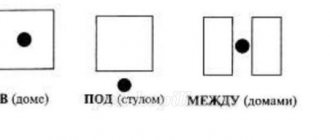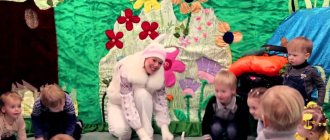Game situations card index (middle group) on the topic
Mail games. Game-situation “The package has arrived” No. 1
The teacher brings the package and tells the children that it came from the Goat’s mother. Educator: “The goat loves her kids, gives them milk, protects them from the wolf. The goat sent the children fresh sour cream. What will we send to the goat? Let's send her apples in a parcel." Children take the balls and put them in the parcel. Educator: “The goat will be happy, she will treat her kids.” The teacher gives the parcel to the children and they play independently (put different gifts in it for grandmother, for mother, for dolls).
Hospital games. Game-situation. “The Bunny Is Sick” No. 2
The teacher-doctor acts out a dialogue with the bunny - the patient. Doctor: “The hospital is opening. I am a doctor. Who came to see me?” Bunny patient (plaintively): “I’ve come.” Doctor: “Sit down, patient. Tell me exactly where your pain is concentrated?" Patient: “I have a cough and my ears hurt.” Doctor: “Let me listen to you. Breathe deeply. (Listen to the patient with a tube.) You are coughing a lot. Show your ears. My ears are inflamed. Now we need to measure the temperature. Take a thermometer. High temperature. You need to take medicine. This. (gives a bottle.) Pour into a spoon and drink every day. Did you understand?" Patient: “Yes. I will take the medicine as you ordered. Thank you Doctor. Goodbye". The game continues without the participation of an adult.
Hospital games. Game-situation “The doctor came to us” No. 3
The teacher points to the toys sitting on the sofa - a bunny, a bear, a doll, a hedgehog - and says: “What a line at the hospital! Animals, are you all sick? But the doctor left to see the sick, and there are no more doctors. What to do? We urgently need a doctor. Who will treat the sick? Lena, will you be a doctor? Will you treat sick animals? Put on a robe. Now you are a doctor. Call the sick into the office." The doctor listens to the patients, looks at the throat, gives medicine. Educator: “Doctor, we have an office in the hospital where they warm their ears and nose. I'm a nurse, I give injections. Your patients will come to me.” Patients are being received. The nurse helps the doctor: writes out a prescription, warms the ears and nose with devices, and gives injections. The teacher says: “I have to go home, my work is over. Who will be the nurse? Olya, come work for me. Bring your dolls to Olya for treatment. She gives the injections well, it doesn’t hurt at all.” The game continues without the participation of an adult.
Shop. Game-situation “doing shopping” No. 4
The teacher takes the bag and says, without addressing the children: “I’m going to the store, I need to buy flour. There's a queue at the store. What are they selling? Flour sugar. Here is the Rita doll. Rita, what do you want to buy? Flour? I'll get in line behind you. Who is our seller? (Addresses the girl.) Lisa, are you a salesman today? Rita and I came to your store.” Buyer (teacher): “Hello, I want to bake a cake, I need flour, give me one bag of flour.” Seller (child): “Here, take it.” Customer: “I still need something for the filling. I love cabbage pies. Do you have any cabbage? Seller: “Yes.” Buyer: “Give me a head of cabbage. And now I need cottage cheese, I’ll bake cheesecakes. I love cheesecakes with raisins. Do you have cottage cheese and raisins?” Seller: “Yes.” Buyer: “Are there any gingerbread cookies?” Are they mint or chocolate?” Seller: “Mint.” Buyer: “I’ll take some gingerbread.” Thank you. My daughter will be happy. She loves pies and gingerbread. Goodbye!"
Shop. Game-situation “What to wear on your feet? No. 5
The teacher turns to the doll standing barefoot: “Katya, why do you have bare feet? You might freeze! There is no one to feel sorry for you. Where is your mother? Olya, isn’t that your daughter running around barefoot? Then you won’t have much trouble with her: her throat will hurt, her temperature will rise, she won’t be able to go for walks.” (Olya approaches the doll and takes it in her arms.) Teacher: “Where are her shoes? No? Then you need to go to the store. Let's go pick out some shoes for your daughter. I work in a shoe store. There's a lot of goods there. Take the bag." The teacher and the girl go to the store. Seller (teacher): “In our store you can pick up whatever you want. What shoes do you want to buy? Boots? Buyer (child): “Yes.” Seller: “Do you prefer red or white shoes?” Buyer: "Red". Seller: “Try on the shoes for your daughter. Did they suit her? Buyer (trying on shoes for the doll): “They fit.” Seller: “Thank you for your purchase. You are happy?". Buyer: Yes. Thank you".
Salon. Game-situation Fashionable hairstyle No. 6
The teacher says: “I am a hairdresser. The queue is long, it’s hard for me to work alone. Who will work as a hairdresser with me? Lena, let's work together. The bear has come to get a haircut.” Lena works, imitating the teacher. Children come with toys or act as clients themselves. Educator: “That’s it, I’ve finished my work. I'm going to the hospital, my throat hurts. Who will take my place? Lisa, be a hairdresser for me. Will you work with Lena?” A new hairdresser—Lisa—comes and accepts clients.
Salon. Game-situation Fashionable hairstyle No. 7
The teacher asks the doll where she got such a beautiful hairstyle. The doll “answers” that she went to the hairdresser. The teacher announces that he is opening a hairdresser and invites the children to visit it. Educator: “The doll Polina came to me. Polina, what do you want to do with your hair? Shall I get my hair cut? Doll: “Hairstyle.” Teacher: “Then sit down more comfortably. (Does her hair.) The hair is ready. Look in the mirror. Like?" Doll: “I like it very much.” Teacher: “Who’s next for me? Hello, Petya. Shall I cut your hair? Sit down. Here are the scissors, here is the comb. The haircut is ready. Do you like it?" Petya: “I like it.” Teacher: “Come again.”
Card file of problem situations for middle group children
Petkunova Karina Mikhailovna
Card file of problem situations for middle group children
1. "Who needs what"
— consolidate
children’s knowledge about objects needed by people of different professions: doctor, cook, salesman.
Progress of the game: the teacher invites the child to find an item necessary for the work of a doctor (cook, seller)
.
2. "If You're Lost"
— introduce
children to the rules of behavior in the current situation .
3. “If someone gets sick”
Goal: to consolidate the knowledge that in case of a serious injury it is necessary to call an ambulance doctor by calling number “03”, to practice calling a doctor.
Progress of the game: If we ourselves cannot cope with the situation , then we call a doctor or an ambulance. Children are asked to call a doctor at home. First, dial the phone number and call it in order: last name, first name -> address -> age -> complaints.
4. "Transport"
. The animals of Africa ask Aibolit for help, but Aibolit does not know how to get to them.
5. «Means of communication»
— The baby elephant’s grandmother got sick. We need to call a doctor, but he doesn’t know how.
children's play ideas and skills , create a desire to organize role-playing games. Help in choosing attributes.
6. "At home"
,
“Properties of Materials”
The piglets want to build a strong house to hide from the wolf and do not know what material to make it from.
7. “How and why does water flow?”
- formation in
children of knowledge that water flows from different vessels in different ways: from a wide one - in a large stream, from a narrow one - in a thin stream;
splashes fly from the outlets; water takes the shape of the vessel into which it is poured. 8. “What happened to the bunny?”
— to form an idea of humane treatment of animals;
develop emotional responsiveness, the desire to participate in solving problem situations .
9. Activating communication (solving problem situations )
on the topic
“What would you do if...?”
10. “Name it correctly”
— clarify
children’s knowledge about vegetables and fruits , their qualities (color, shape, taste),
consolidate the ability to recognize them and give a brief description.
11. “There is one toy, but there are many of us”
- promote the development of negotiation skills.
12. "If someone gets hurt"
— continue to introduce
children to basic first aid techniques.
13. “This way or that way”
— to develop
children’s to distinguish life-threatening situations from non-threatening ones ;
develop attention. 14. “They brought a new toy to the group , and everyone wants to play with it. What to do?" - cultivate a friendly attitude towards each other, teach to play together without taking toys away from each other, teach to share toys
15. "Who's there"
— discuss with children the rules of behavior in
the situation of a visit from a stranger, teach how and who to turn to for help.



